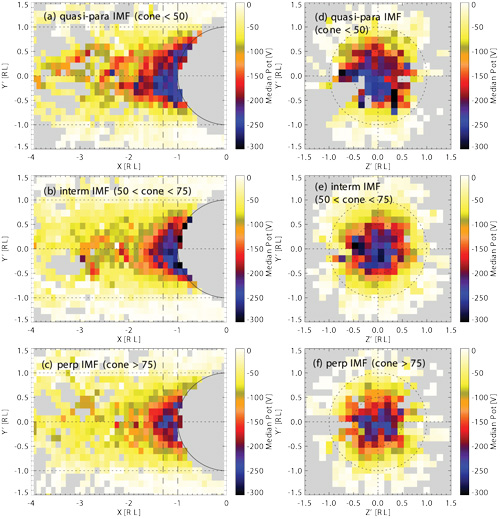2019 ARTEMIS SCIENCE NUGGETS
Mapping the Lunar Wake Potential Structure with ARTEMIS Data
by Shaosui Xu
Space Sciences Laboratory, UC Berkeley
Introduction
The lunar wake is a nearly complete plasma void immediately downstream from the nightside hemisphere of the Moon due to the removal of solar wind ions and electrons on the dayside. The refilling of the wake by the supersonic solar wind flow is facilitated by the wake ambipolar electric potential, formed by electrons with high thermal speeds running ahead of ions. However, the field-aligned wake potential is not a directly measured quantity, and thus, a statistical analysis of wake potentials at high altitudes has not been previously performed. In this study, we systematically investigate the wake potential structure with both an analytical model and ARTEMIS data, focusing in particular on the asymmetry in the wake potential.
The refilling of the lunar wake is relatively well explained by the theory of 1-D plasma expansion into a vacuum. We first upgraded this theory to apply in two dimensions within the plane of the interplanetary magnetic field and the solar wind velocity to examine how a tilted interplanetary magnetic field (IMF) affects the wake potential structure. Then, we utilized ARTEMIS measurements from 2011 to 2018 to statistically map the lunar wake potential structure, obtained by comparing the field-aligned electron distribution functions in the wake with those outside of the wake for each orbit, and compared the observations with our 2-D model.
| Figure 1. (a) Modeled wake potential under a solar wind speed of |Vsw| = 400 km/s, an electron temperature of Te = 24 eV, and an IMF angle of 135° to the X-axis. (b) The averaged potential from our analytical model in the Y-Z plane for X = [-1.3, -1.0]. |
Plasma Expansion Theory for a Tilted IMF
The analytical potential from our 2-D model is illustrated in Figures 1 for a tilted IMF. An obvious wake potential asymmetry is present, more negative on the -Y side, arising from a shorter expansion time from the -Y side than at the +Y side so that the +Y side has a longer relaxing time and thus shallower potentials.
Statistical Mapping with ARTEMIS Data
The statistical maps of wake potentials derived from ARTEMIS data for three IMF tilting scenarios (or three cone angle ranges) are displayed in Figure 2. To avoid averaging out the asymmetry, we have rotated the coordinate frame such that the X-axis is opposite to the solar wind flow, the Y-axis is parallel or anti-parallel to the perpendicular component of the IMF but with the leading end of the IMF always lying in +Y, with the Z-axis completing the right-handed system. The wake potential is much more extended for more parallel IMFs (smaller cone angles), comparing Figures 2a-2c, in agreement with classic theories. This is due to a much longer expansion distance for more parallel IMFs. In addition, a pronounced asymmetry in the potential structure can be seen for quasi-parallel and intermediate IMFs (Figures 2a and 2b), in contrast to the symmetric wake potentials for perpendicular IMFs (Figure 2c). The results in Figure 2c represent the simplest scenario, for symmetric solar wind electron distributions and a perpendicular IMF to the solar wind velocity. Figures 2d-2f show the projection in the Y-Z plane. Similarly, the potentials are more negative in the -Y side than the +Y side for quasi-parallel and intermediate IMF (Figures 2d and 2e) but are increasingly symmetric to the Y axis for perpendicular IMF (Figure 2f). Finally, the potential patterns for the parallel IMF case (Figure 2a and Figure 2b) agree well with our model results shown in Figure 1.
| Figure 2. The maps of wake potentials derived from ARTEMIS observations: (a-c) in the X-Y plane averaged over Z = [-0.5, 0.5]; (d–f ) in the Y-Z plane averaged over X = [-1.3, -1.0] (as indicated by the two vertical dashed lines in (a)–(c). (a and d) Quasi-parallel IMFs (cone angle <50°); (b and e) Intermediate IMFs (50° < cone angle < 75°); (c and f) Perpendicular IMFs (cone angle > 75°). Cone angle = arccos(|Bx|/|B|). |
Conclusions
We have developed an analytical model of the lunar wake potential in a 2-D plane for a tilted IMF. The analytical solutions predict an asymmetry in the wake potential for a tilted IMF, caused by different plasma expansion times for the two sides of the wake. This wake potential asymmetry is confirmed by data. For more perpendicular IMF, the lunar wake potentials derived from ARTEMIS observations are quite symmetric to the X axis. In contrast, when the IMF is tilted, or more parallel, the wake potential pattern shifts to the −Y side, in agreement with our model.
In this study, we have also shown that the derived potentials from ARTEMIS data vary with solar wind electron temperature and bulk flow velocity as the theory predicts. Moreover, ambipolar electric fields are obtained from both the modeled and data-derived wake potentials and show relatively good agreement. Lastly, we examine the effects of the solar wind strahl-electron population on the wake potential structure, which appears to cause a net potential difference across the lunar shadow. This may imply that the disturbance of the wake plasma expansion extends farther outside the wake than previous plasma-expansion theories have predicted.
References
Xu, S., Poppe, A. R., Halekas, J. S., Mitchell, D. L., McFadden, J. P., Harada, Y. (2019). Mapping the lunar wake potential structure with ARTEMIS data. Journal of Geophysical Research: Space Physics, 124.Biographical Note
Shaosui Xu is an Assistant Research Physicist at the Space Sciences Laboratory / UC Berkeley. Her research includes analysis of ARTEMIS data regarding solar wind interaction with the Moon, as well as energetic electron transport at Mars and Earth, the Martian ionosphere and magnetosphere, and other unmagnetized bodies' plasma environments. More information can be found at: https://www.ssl.berkeley.edu/science/groups/planetary-members/name/shaosui-xu/
 Please send comments/suggestions to
Emmanuel Masongsong / emasongsong @ igpp.ucla.edu
Please send comments/suggestions to
Emmanuel Masongsong / emasongsong @ igpp.ucla.edu

